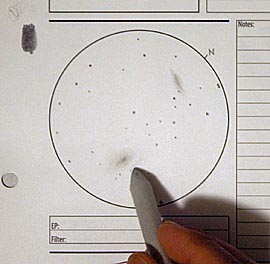
Next I pick up a blending stump and scrub it in the dark patch to pick up enough graphite to paint in the light object. Before using the blending stump as-is, I’ll usually test it out somewhere outside the circle to be sure it isn’t too dark. If it is too dark, I scrub it around a bit in a blank space to get rid of excess graphite. |

Now I dim the red light a bit, to better see the fainter objects in the eyepiece, and then lightly swirl them in with the blending stump. I start with as light of pressure as possible, and slowly build it up to an appropriate darkness. Since I’m trying to depict things as accurately as possible, I pay careful attention to the framework of stars and where the object sits in this framework. As I build up layers of graphite, I also pay attention to which portions of the object are brighter than others, and darken those more, dipping into the dark patch outside the circle when I need to freshen up the stump. |

In some cases, I’ll find that it’s beneficial to get the pencil back out and use it to add finer details in the object that the blending stump can’t handle. For example, the core of M81 was bright and condensed. I wasn’t able to use the blending stump to indicate it tightly and strongly enough. So I started to lightly swirl it in with the pencil. Since the area had already been lightly covered by the blending stump, the paper didn’t have as much tooth, so the darkness of the pencil was much easier to restrain. I came back in with the blending stump and softened the penciled-in core just a bit. |

At this stage, I’ll turn the red light down a bit more, and spend more time at the eyepiece, looking for more subtle details. Keeping my eyes off the sketch pad for a longer time often helps me to see more. Once I feel I’ve spotted a difficult detail, I’ll try to memorize its position, size and shape against the background stars, and it’s relation to the rest of the extended object. Then I go back to the sketch and lightly indicate it. In this case, I felt I could see a very dim, soft arc northeast of M81. I try to keep it subtle, in keeping with how hard it might have been to see. But because objects in sketches just don’t flicker in and out of view, these things will often appear a bit more obvious in the sketch than they were in the eyepiece. I don’t yet know how to deal with this…unless I start animating my sketches to flicker things in and out. (No.) |
PAGE 2 OF 3
PREVIOUS PAGE | NEXT PAGE
Related